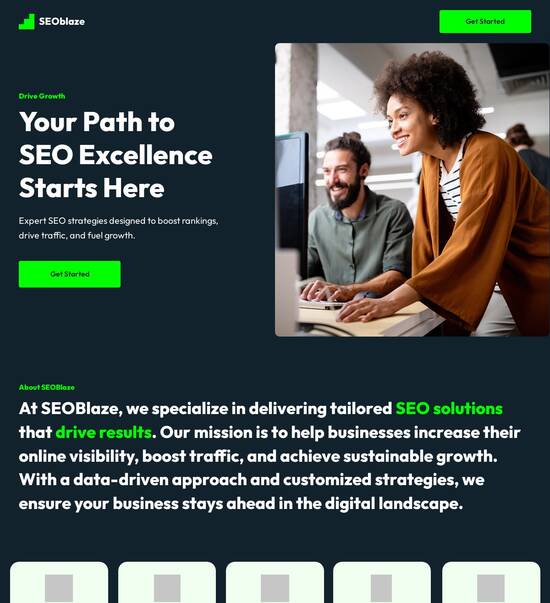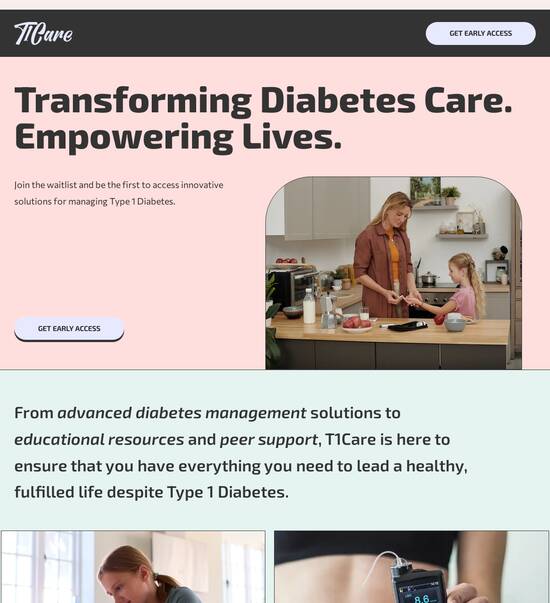
HTML page template for Accounting
Use TemplateAbout template
Conquer your niche with our high-converting landing page templates for your Accounting business. Let's boost conversion rates together!
Recommended templates

Easy to build without coding
With the intuitive drag-and-drop builder, anyone on your team can create high-converting pages without any knowledge of code or design. Make enhancements to your landing page with custom widgets using Javascript, HTML/CSS, or third-party scripts.

Multiple layouts for any industry and goal
Select from 500+ landing page layouts built to boost conversions across industry-specific scenarios. Customize them by adjusting fonts, adding images, and generating on-brand content with the AI assistant. Quickly scale with Instablocks® and Global Blocks that you can save, reuse, and update globally.

Loads fast and looks polished on any device
Every template is responsive, which means they present professionally on any device and load blazingly fast with our Thor Render Engine. You can also power them up with Google AMP technology to deliver an unparalleled mobile experience and drive higher conversions.

Robust analytics & experimentation
Get real-time updates and reporting across all your devices, showing the number of visitors, conversions, cost-per-visitor, and cost-per-lead. Launch AI-powered experiments, run A/B tests, and use heatmaps to analyze user behavior, then optimize your landing page to maximize conversions.







Easy to build without coding
With the intuitive drag-and-drop builder, anyone on your team can create high-converting pages without any knowledge of code or design. Make enhancements to your landing page with custom widgets using Javascript, HTML/CSS, or third-party scripts.
Multiple layouts for any industry and goal
Select from 500+ landing page layouts built to boost conversions across industry-specific scenarios. Customize them by adjusting fonts, adding images, and generating on-brand content with the AI assistant. Quickly scale with Instablocks® and Global Blocks that you can save, reuse, and update globally.
Loads fast and looks polished on any device
Every template is responsive, which means they present professionally on any device and load blazingly fast with our Thor Render Engine.
Robust analytics & experimentation
Get real-time updates and reporting across all your devices, showing the number of visitors, conversions, cost-per-visitor, and cost-per-lead. Launch AI-powered experiments, run A/B tests, and use heatmaps to analyze user behavior, then optimize your landing page to maximize conversions.
All the features you need to build accounting html template free
Explore more featuresLearn how to build accounting websites templates
FAQs
Leading the way in building high-performing landing pages





A complete guide to Instapage for converting landing pages
When it comes to maximizing ROI from digital marketing campaigns, using Instapage can significantly enhance your approach. This guide will walk you through creating high-converting landing pages and optimizing them for peak performance, tailored for marketers in sectors like business services, tech, education, and financial services located in the USA.
Understanding Instapage's value for marketers
Instapage is an all-in-one landing page and conversion rate optimization (CRO) platform that equips marketers with tools to create, optimize, and manage campaigns effectively. For audiences in government and education, its personalization capabilities ensure each promotional effort resonates with the target demographic.
- 100+ high-converting templates: Start with professionally designed templates that best fit your campaign’s goal and audience.
- Intuitive page builder: Create landing pages easily without needing any coding skills, enabling quick launches.
- Built-in analytics: Measure performance instantly through detailed dashboards to identify what works and what doesn’t.
Steps to Create a High-Converting Landing Page on Instapage
Begin with a clear strategy for your landing page to engage users effectively. Here are the steps:
- Define your objective: Understand your campaign goal, whether it's lead generation or product promotion.
- Choose the right template: Select from Instapage's library tailored to your purpose.
- Implement personalization: Use dynamic text replacement and AdMaps to align your landing page with your marketing strategy.
Optimizing Your Landing Pages for Higher Conversions
To ensure your landing pages perform at their best, consider these optimization techniques:
- Conduct A/B tests: Experiment with different headlines, layouts, and CTA buttons to see what yields better results.
- Utilize heatmaps: Analyze user engagement on your page, identifying areas of interest and drop-off.
- Refine targeting: Use Instapage’s audience management tools to tailor experiences based on visitor behavior.
Once your landing pages are set up and optimized, continually monitor their performance and adjust strategies as needed based on collected data.
In conclusion, using Instapage’s powerful features not only streamlines the landing page creation process but also boosts your overall campaign effectiveness. The flexibility and performance insights available through Instapage are crucial for marketers aiming to achieve substantial ROI.
Ready to take your digital marketing campaigns to the next level? Start using Instapage today to unleash the full potential of your landing pages!
Understanding HTML page templates for accounting: Crafting efficient financial web solutions
The significance of HTML page templates in accounting
HTML page templates serve as foundational elements for creating streamlined digital experiences. They are predefined webpage layouts developed using HTML, CSS, and JavaScript, designed to reduce the complexity of website creation. For accounting professionals, these templates are vital as they facilitate faster website deployment that can accurately reflect professional identities. By utilizing ready-made structures, accountants can focus more on content and essential functionalities rather than the fundamental design.
The accounting industry often deals with sensitive information and the need for trust. Using professionally designed HTML templates can help convey reliability and expertise. Moreover, these templates accommodate specific needs, reflecting the industry’s meticulous attention to detail. This clear presentation not only showcases services but also enhances client confidence.
Ensures a consistent branding approach across digital platforms.
Facilitates quick updates while maintaining formatting coherence.
Empowers non-technical users to manage and modify website content easily.
Critical features of accounting HTML page templates
A successful accounting HTML template must prioritize responsive design. As an increasing number of users access financial services from mobile devices, ensuring that templates adapt seamlessly to various screen sizes is crucial. Responsive design involves flexible grids, images that scale appropriately, and the use of media queries to deliver a tailored experience regardless of device type.
Customizable financial widgets represent another essential feature for accounting templates. Tools such as financial calculators, expense tracking graphs, and budget planners can greatly enhance user interaction. These interactive tools empower clients to engage with their financial data directly on the website, thereby fostering a more personalized experience that emphasizes the service provider's added value.
Incorporates features like interactive graphs to visualize budgets and expenditures.
Offers calculators for tax estimations, loan assessments, etc.
Utilizes client input dynamically to tailor financial solutions effectively.
Technical aspects of HTML page templates
Understanding the Document Object Model (DOM) is essential for anyone working with HTML templates in accounting. The DOM is a programming interface that browsers use to represent the structure of a webpage, allowing for the dynamic updating of content and structure. This interactivity can greatly benefit accounting services, as it enables real-time updates of financial data, essential for user engagement.
Incorporating event handling with JavaScript further enhances user interaction. By leveraging methods such as `document.addEventListener`, developers can create responses to user actions, like validating input fields or processing form submissions. For accounting templates, this translates into smoother user experiences—where clients can easily submit reports, queries, or calculations.
Ensures real-time data updates convey unambiguous financial information.
Improves client experience through efficient form handling mechanisms.
Utilizes seamless transitions to enhance engagement and reduce desktop clutter.
Development of HTML page templates for accounting
When developing HTML page templates for accounting, it’s pivotal to plan the template structure carefully. This involves identifying key components specific to accounting services, such as detailed service descriptions, client testimonials, and relevant financial calculations. A well-organized template should intuitively direct users through available services, leading them towards desired actions.
Coding best practices, including maintaining clean and organized code, are equally important. Clear commenting within the HTML/CSS documents aids future modifications and maintenance. Furthermore, developers should avoid common pitfalls such as excessive inline styles and avoid redundancy through modular coding techniques.
Organize CSS effectively to allow for easier updates.
Use semantic HTML elements to enhance accessibility.
Regularly validate code to ensure compliance with standards.
Enhancing usability: user interface design principles
User-centric design is paramount for accounting HTML templates. This involves understanding who the users are—potential clients seeking trustworthy financial advice or existing clients needing service management. By developing user personas, designers can identify necessary features and customize the experience, ensuring that the layout and content resonate with user expectations.
Aesthetic considerations also play a critical role in user experience. Selecting the right color schemes and typography is essential, as these elements influence perceptions of reliability and professionalism. Imagery should align with the accounting theme, engendering a sense of security and confidence in potential clients.
Choose professional color palettes that reflect brand identity.
Utilize fonts that are easy to read and convey professionalism.
Incorporate client-centric visuals that promote emotional engagements, such as family-oriented images.
Integrating advanced features into accounting templates
Security features are non-negotiable when dealing with HTML page templates in the accounting domain. Protecting sensitive financial data is a priority that necessitates secure coding practices. Implementing HTTPS, utilizing JavaScript validation, and back-end authentication are fundamental practices that help safeguard client data, fostering trust and reliability.
In addition to security, integrating third-party tools can significantly enhance the functionality of accounting templates. Popular integrations include CRM systems, which streamline client management, and automated email marketing tools for engaging audiences effectively. Utilizing APIs can enable real-time updates for financial calculations, ensuring that users receive the latest information and tools seamlessly.
Incorporate security protocols such as data encryption and secure access methods.
Utilize third-party services that enhance functionalities, such as payment gateways or lead capture forms.
Regularly monitor third-party integrations to manage compliance properly.
The future of HTML page templates in the accounting sphere
As web design evolves, HTML page templates for accounting are poised for notable advancements. Emerging trends such as the adoption of minimalistic design and seamless user experiences will influence template development. Furthermore, integrating blockchain technology into financial services could revolutionize accountability and transparency, creating new opportunities for web solutions.
AI and machine learning are also set to transform the landscape for accountants. These technologies can analyze user behavior to optimize templates dynamically, catering to user preferences for a personalized experience. As the realm of web design continues to evolve, staying updated on advancements will be crucial for accounting professionals seeking an edge in their online presence.
Exploration of trends focusing on UX that prioritize efficiency and simplicity.
Leveraging AI to tailor web experiences to individual user needs.
Enhancing template functionality through integration with innovative technologies like blockchain.
Case studies: successful implementations of HTML page templates
Examining real-world examples of accounting firms utilizing HTML templates illustrates their effective application. For instance, a small tax consulting firm revamped its website with an HTML template that included accessible service descriptions and real-time calculators. This transition not only improved their visibility but also attracted a broader client base, showcasing the critical role of user experience.
Metrics for success reveal the effectiveness of such implementations. After the redesign, firms typically see increases in user engagement, client inquiries, and overall satisfaction. Metrics such as bounce rates, pages per session, and conversion rates provide valuable insights into the impact of template-driven enhancements on business performance.
Increased engagement through improved page layouts leading to longer user sessions.
Higher conversion rates due to interactive elements facilitating user trust.
Enhanced client retention due to easier navigation and information retrieval.
Conclusion: the transformative power of HTML page templates for accountants
The advantages of incorporating HTML page templates into accounting practices are multifaceted. From expediting the design process to enabling seamless updates, these templates empower firms to maintain professionalism and efficiency in their online representation. The ease of customization and integration with essential tools further positions HTML templates as invaluable assets in the digital landscape.
As technology continues to advance, adapting and adopting these tools will be critical for accountants. Embracing the possibilities of HTML templates allows firms to thrive in an increasingly digital world, delivering value to clients while optimizing their workflows. By remaining flexible and receptive to change, accounting professionals can truly enhance their services and client experiences.
Ready to skyrocket conversions?
Supercharge your ad campaigns with high-performing landing pages
Get started














